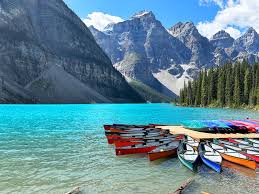Banff Wildlife Tours
Spot bears, elk, bighorn sheep, and iconic Canadian Rockies wildlife in their natural habitat!

Experience Banff's incredible wildlife in one of North America's best wildlife viewing destinations! Banff National Park is home to grizzly bears, black bears, elk, bighorn sheep, mountain goats, wolves, cougars, moose, deer, and countless bird species. Wildlife tours venture to prime viewing areas during peak activity times (dawn and dusk) with expert guides who know animal behavior, seasonal patterns, and safe viewing practices. Spring brings newborn elk calves and bear emergence; fall features elk rutting season with bugling bulls; winter offers easier wildlife spotting against snow. Learn about conservation efforts protecting these species, how animals adapt to harsh mountain climates, and Parks Canada's wildlife corridors. Tours include spotting scopes, binoculars, and photography tips. It's safari-style wildlife viewing in the Canadian Rockies!
Why Choose Wildlife Tours in Banff?
Iconic Rockies Wildlife
See grizzlies, elk, bighorn sheep, and more in pristine wilderness!
Expert Wildlife Guides
Guides know animal behavior, tracking, and best viewing locations.
Photography Opportunities
Spotting scopes and expert positioning for incredible wildlife photos.
Safe Viewing
Maintain proper distances and learn bear safety from professionals.
Types of Wildlife Tours in Banff
Bear Watching Tours
Early morning or evening tours targeting grizzly and black bear habitats.
Elk Viewing Tours
Observe massive bull elk especially during fall rutting season.
Wildlife Photography Tours
Specialized tours for photographers with optimal lighting and positioning.
Full-Day Wildlife Safari
Comprehensive tour covering multiple habitats and species.
What to Expect on Your Banff Wildlife Tours
Duration
Morning tours: 3-4 hours. Evening tours: 2-3 hours. Full-day safaris: 6-8 hours.
Bear Encounters
Spring-fall sightings of grizzlies and black bears feeding on berries and vegetation.
Elk & Bighorns
Elk in valleys, bighorn sheep on mountain slopes - iconic Rockies animals.
Spotting Equipment
Guides provide binoculars and spotting scopes for close-up views.
Prime Locations
Visit Bow Valley Parkway, Vermillion Lakes, and wildlife corridors.
Conservation Education
Learn about Parks Canada wildlife protection and human-wildlife coexistence.
Expert Tips for the Best Experience
Dawn (6-8 AM) and dusk (6-8 PM) are peak wildlife activity times - book accordingly.
Fall (September-October) is best: Elk rutting season, bears feeding pre-hibernation, fewer tourists.
Spring (May-June) offers bear cubs and newborn elk calves - adorable but keep distance!
Bring telephoto lens (200mm+) for wildlife photography - never approach animals.
Bow Valley Parkway often closes March-June to protect bears - check before planning.
Winter wildlife spotting excellent - animals easier to see against snow, fewer crowds.
Dress in layers and neutral colors (not bright). Bring warm jacket even in summer.
100m distance from bears, 30m from elk/sheep required by law - guides ensure compliance.
Frequently Asked Questions
Q:Will I see bears in Banff?
A: Good chance but not guaranteed - wildlife is wild! Spring-fall (May-October) best for bear sightings. Guides know hotspots and track recent sightings increasing odds. Morning/evening tours see more wildlife. Even without bears, you'll see elk, sheep, and stunning scenery!
Q:Are wildlife tours safe?
A: Yes! Guides are Parks Canada certified, carry bear spray, and maintain safe distances (100m from bears, 30m from elk). They monitor animal behavior and prioritize safety. Following guide instructions keeps everyone safe.
Q:When is the best time for wildlife viewing?
A: Fall (September-October): Elk rutting, bears feeding heavily, amazing! Spring (May-June): Bear cubs, newborns. Summer (July-August): Most active dawn/dusk. Winter: Easier spotting on snow. Dawn/dusk always best regardless of season.
Q:What animals will I see?
A: Likely: Elk, bighorn sheep, deer, ground squirrels. Common: Black bears, mountain goats. Possible: Grizzly bears, moose, wolves, eagles. Rare: Cougars, wolverines (elusive). Guides maximize chances by knowing patterns and recent sightings.
Q:How close can you get to wildlife?
A: Legal distances: 100m (3 bus lengths) from bears/wolves, 30m from elk/sheep. Guides provide spotting scopes for close-up views. NEVER approach wildlife - dangerous and illegal. Fines up to C$25,000 for harassing wildlife!
Q:Can I take photos of wildlife?
A: Absolutely! Bring telephoto lens (200mm+ recommended). Guides position vehicle/group for best shots and provide photography tips. Spotting scopes allow phone photography through lens. Early morning/evening best light. Respect distance rules always.
Q:What should I bring?
A: Binoculars (often provided), camera with telephoto lens, warm layers, water, snacks. Neutral-colored clothing. Sunscreen and hat. Tours typically provide bear spray and spotting scopes. Dress for weather changes - mountain conditions unpredictable!
Q:Are there grizzly bears in Banff?
A: Yes! Banff has both grizzly and black bears. Grizzlies are larger, have shoulder hump, and are more rare to spot. Both species protected. Guides trained to identify species and keep safe distances. Spring-fall best for sightings.
Why Visit Banff?
Iconic Lake Louise and stunning mountain scenery
World-class hiking and outdoor activities
Abundant wildlife and nature encounters
Beautiful Banff National Park landscapes
Charming mountain town atmosphere
Perfect blend of adventure and natural beauty
Best Time to Visit
Weather
Banff enjoys a mountain climate with cool summers and cold winters. Summers are mild (50-75°F/10-24°C), winters are cold (10-30°F/-12-1°C), and the weather can be unpredictable year-round.
Best Months
June to September offers the best weather with mild temperatures, clear trails, and perfect conditions for outdoor activities.
Peak Season
July to August brings peak tourist season with ideal weather, larger crowds, and higher prices.
Off Season
October to May offers lower prices and fewer crowds, though with cold weather and snow.
Plan Your Banff Trip
Transportation Tips
Renting a car is recommended for exploring the area. Organized tours provide access to remote areas, and shuttle services are available for popular destinations.
Car Rental Deals in Banff
Rent a car for maximum flexibility and explore at your own pace on Expedia USA.
Where to Stay
Find the perfect accommodation for your Banff adventure. From luxury resorts to cozy hotels, we've got you covered.
Best Hotel Deals in Banff
Discover top-rated hotels with exclusive rates and special offers on Expedia USA.